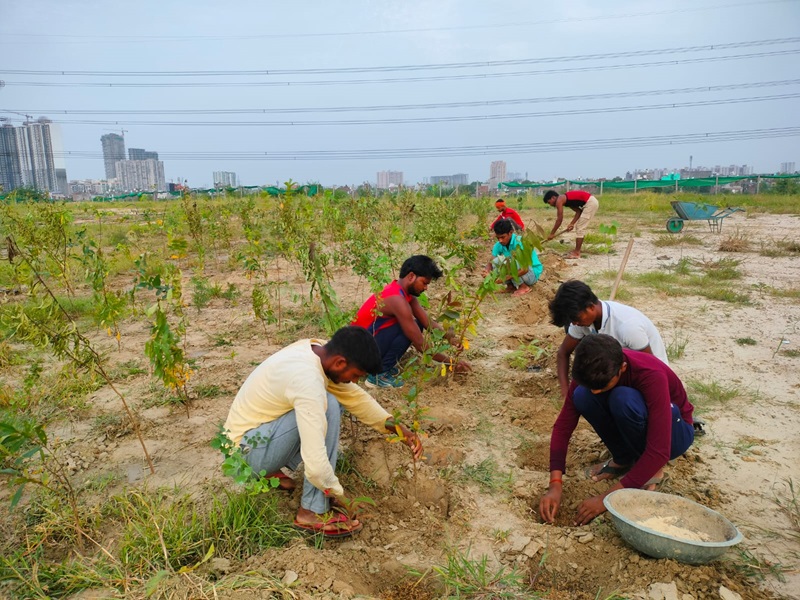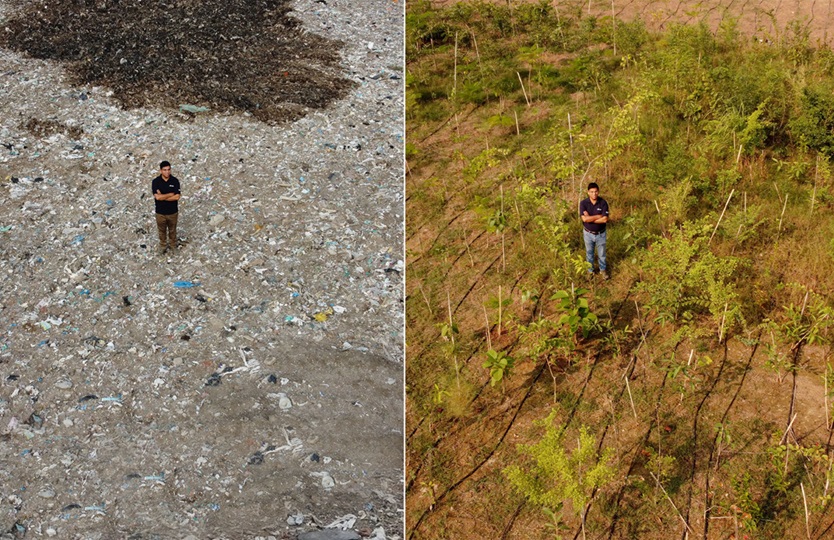Introduction

Environmental degradation and pollution are pressing concerns in urban areas, particularly in regions like the National Capital Region (NCR) of India. The Siddhartha Vihar landfill in Ghaziabad epitomized such challenges, with uncontrolled waste dumping and burning severely affecting air and groundwater quality. In the year 2022, SankalpTaru Foundation, embarked on a project to transform this landfill into a green, sustainable forest, aiming to plant 40,000 native trees and provide multiple ecological and socio-economic benefits.
Project Background
Ghaziabad faces significant pollution issues, with many areas identified as highly dust-polluted. The Siddhartha Vihar landfill, accumulating both garbage and construction waste, posed severe environmental and health risks due to the uncontrolled burning of waste and subsequent release of harmful pollutants. This project, initiated in 2022, sought to address these challenges by converting the landfill into a vibrant forest, enhancing green spaces in the Delhi NCR region.
Objectives
- Transform the landfill into a green space by planting 40,000 native trees
- Improve air quality and mitigate pollution
- Enhance groundwater recharge and local biodiversity
- Provide socio-economic benefits to the local community
Methodology
Site Preparation:

- Land Survey and Approval: Obtained necessary approvals from local authorities and conducted a detailed land survey
- Land Cleaning: Removed waste from the site, which was handed over to the Material Recovery Facility (MRF) of the Ghaziabad Municipal Corporation (GMC)
- Land Levelling and Soil Filling: Utilized the plane method for precise land levelling and imported fertile soil to enhance soil conditions
- Fencing and Irrigation Installation: Installed cement pole fencing to protect saplings from animals and set up a solar-powered irrigation system
Plantation Process:

- Species Selection: Chose native species based on their ecological and socio-economic benefits, including CO2 sequestration potential and adaptability to local conditions
- Pit Digging: Employed machine-powered pit digging for high-density plantation
- Nutrient Management: Applied a mix of cocopeat, manure, soil, and water to provide necessary nutrients for sapling growth
- Geo-Tagging: Implemented geo-tagging for each planted tree to monitor growth and survival
Post-Plantation Maintenance:
- Continuous Monitoring: Dedicated team members reside on-site to provide 24×7 maintenance and the nurturing of the planted saplings
- Regular Care: Activities include regular watering, weeding, and nutrient application.
Results


Environmental Impact:
- Carbon Sequestration: Planted over 40,000 saplings, expected to sequester approximately 48,222 tons of CO2 in the years to come
- Oxygen Generation: Expected to generate around 32,272 tons of oxygen, contributing to improved air quality.
- Land Restoration: Successfully restored approximately the land from a waste dump to a green oasis
Biodiversity Enhancement:

- Attracted various avifaunal species, enhancing local biodiversity. Notable sightings include the Common Hoopoe, Common Wood Pigeon, and Indian Rose-ringed Parakeet.
Socio-Economic Benefits:
- Improved air quality and aesthetic value of the area.
- Potential for increased community engagement and environmental education.
- Long-term benefits include enhanced groundwater recharge and climate resilience.
Challenges
- Soil Infertility: Addressed by importing fertile soil and using organic manure.
- Irrigation: Implemented a solar-powered irrigation system to overcome water scarcity.
- Protection of Saplings: Ensured sapling survival through fencing and continuous maintenance.
Conclusion


The transformation of the Ghaziabad landfill into a sustainable forest showcases the effectiveness of community-driven environmental restoration. The project not only mitigated pollution but also created a green space that enhances local biodiversity and provides socio-economic benefits. This case study demonstrates the potential for replicating such initiatives in other urban areas facing similar environmental challenges.
Future Directions
- Monitoring and Research: Continuous monitoring of the plantation site to study long-term ecological impacts.
- Community Engagement: Increased involvement of local communities in maintenance and educational programs.
- Scalability: Exploration of similar projects in other regions to promote urban afforestation and environmental sustainability.

